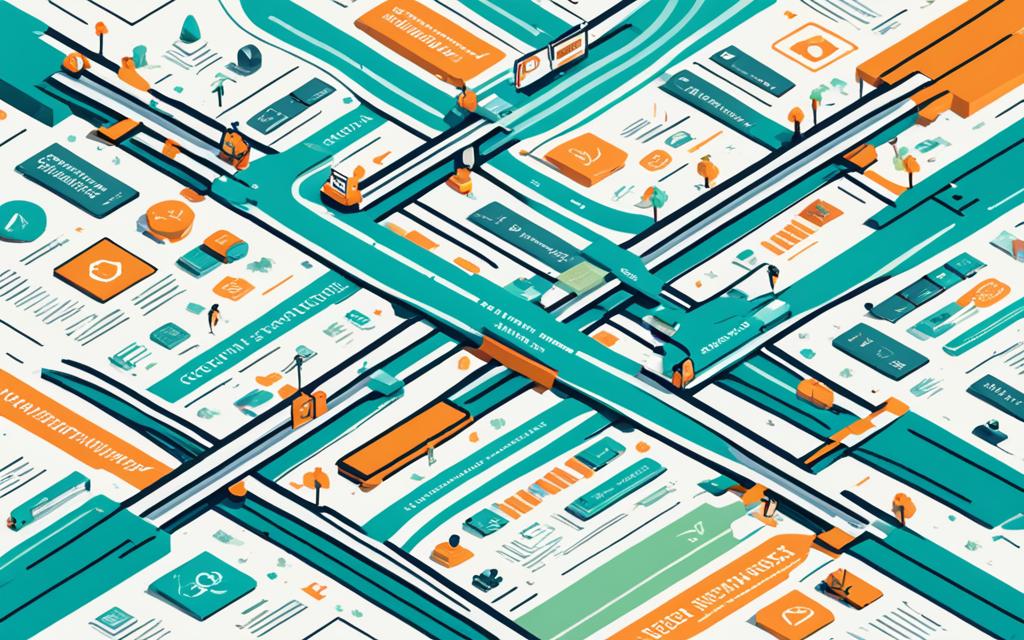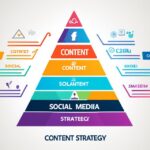Table of Contents
Welcome to our article on the intersection of content strategy and user experience. In today’s digital era, where user satisfaction is paramount, understanding how content strategy and user experience intersect is crucial for businesses seeking to create successful and engaging online platforms.
The way users interact with digital platforms plays a vital role in determining their overall satisfaction. By incorporating effective content strategy and user experience principles, businesses can enhance digital interactions and create experiences that resonate with their target audience.
In this article, we will explore the various aspects of this intersection, including understanding user intent, crafting engaging copy, organizing information architecture, considering visual hierarchy, creating seamless content integration, and enhancing accessibility and readability.
By delving into these key areas, we will uncover how businesses can create a harmonious blend of content strategy and user experience to create captivating online experiences. So, let’s dive in and discover the secrets to maximizing user satisfaction through the intersection of content strategy and user experience.
Understanding User Intent
Understanding user intent is crucial for creating content and designing user experiences that resonate with the audience. By gaining insights into user behavior and search intent, businesses can tailor their content to provide the most value and engage users effectively. User intent refers to the underlying motivation or purpose behind a user’s online search or interaction with a website.
User behavior analysis helps businesses understand how users navigate websites, interact with content, and engage with various features. By analyzing user behavior metrics such as click-through rates, bounce rates, and time spent on page, businesses can gain valuable insights into what drives user engagement and identify areas for improvement.
In addition, understanding search intent is crucial for optimizing content for search engine visibility. Search intent refers to the specific goal or information users are seeking when conducting a search. By aligning content with user search intent, businesses can improve their visibility in search engine results pages (SERPs) and increase the likelihood of attracting relevant and engaged users.
User engagement is a key metric that measures how users interact with a website or specific content. It includes actions such as clicking on links, watching videos, submitting forms, or making purchases. By understanding user intent and tailoring content to meet user needs, businesses can enhance user engagement and increase the likelihood of conversions, sales, or desired actions.
Why Understanding User Intent Matters
“Understanding user intent allows businesses to create content that speaks directly to their target audience and fulfills their needs.”
By understanding user intent, businesses can create content and design user experiences that align with user expectations and goals. This leads to several benefits:
- Improved relevance: When businesses align their content with user intent, it becomes more relevant and valuable to users’ needs. This increases the likelihood of users engaging with the content and finding it useful.
- Increased user satisfaction: By meeting user expectations and providing the information or solutions they are seeking, businesses can enhance user satisfaction. This fosters a positive perception of the brand and encourages users to engage further.
- Higher conversion rates: When businesses understand user intent, they can create targeted content that persuades users to take desired actions. This can include signing up for a newsletter, making a purchase, or requesting a quote. By tailoring content to user intent, businesses can increase conversion rates and achieve their business goals.
- Improved SEO performance: By aligning content with user intent, businesses can improve their website’s visibility in search engine results. Search engines aim to provide users with the most relevant and useful content based on their search intent. By understanding user intent, businesses can optimize their content for relevant keywords and improve their SEO performance.
Understanding user intent is an ongoing process that involves continuously monitoring user behavior, analyzing search trends, and adapting content to meet changing user needs. By taking a user-centric approach and prioritizing user intent, businesses can create content and user experiences that resonate with their audience, foster deeper connections, and ultimately drive success.
Crafting Engaging Copy
To create truly engaging copy, it is essential to understand the preferences of your audience and capture their attention right from the start. By empathizing with their perspectives and addressing their specific concerns, businesses can develop copy that is not only engaging but also compelling. Attention-grabbing headlines, storytelling techniques, and clear calls-to-action can guide users through the content and persuade them to take desired actions.
One effective way to capture audience attention is by leveraging the power of relatable stories. By incorporating real-life scenarios or testimonials into your content, you can create an emotional connection with your audience and make your message more relatable. This storytelling approach helps you to communicate your key messages in a memorable and impactful manner.
Additionally, understanding the influencing factors of your audience’s decision-making process allows you to tailor your messaging accordingly. By highlighting the unique selling points of your product or service that resonate with your audience’s preferences, you can create a sense of urgency and increase conversion rates. This strategy allows you to address their pain points and position your offering as the solution they have been looking for.
Remember, the goal is to craft copy that not only captures attention but also keeps your audience engaged throughout the entire customer journey. When your messaging is compelling and aligns with their needs, your audience is more likely to remain interested and take the desired actions.
Moreover, clear and concise calls-to-action are essential for guiding your audience towards the next steps. Use action-oriented language and reinforce the benefits they will gain by taking action. By creating a sense of urgency and providing a clear path forward, you can increase the likelihood of conversion.
Example of an Engaging Copy:
“Are you tired of struggling with high energy bills? Discover our energy-efficient solutions that can save you up to 30% on your monthly expenses. Join thousands of satisfied customers who have already made the switch to greener living. Take the first step towards a brighter future today!”
By following these strategies and understanding your audience’s preferences, you can create engaging copy that captures attention, resonates with your audience, and compels them to take action.
| Engaging Copy Techniques | Description |
|---|---|
| Attention-Grabbing Headlines | Use compelling and intriguing headlines to pique the interest of your audience. |
| Storytelling | Incorporate relatable stories or testimonials to create an emotional connection with your audience. |
| Addressing Pain Points | Highlight the unique selling points of your product or service that address your audience’s specific concerns. |
| Clear Calls-to-Action | Create concise and action-oriented calls-to-action that guide your audience towards desired actions. |
Organizing Information Architecture
Organizing information architecture is essential for guiding users through the content in an intuitive way. It involves creating a hierarchical structure that prioritises important information and allows for easy user navigation. By considering the user’s journey and designing a structure that aligns with their expectations, businesses can enhance the user experience and increase engagement.
Effective information architecture improves user navigation by presenting content in a logical and organised manner. By structuring the content hierarchically, starting from broad categories and gradually narrowing down to specific details, users can easily locate the information they need.
One way to achieve a hierarchical structure is by implementing a navigation menu or sidebar that provides users with an overview of the site’s main sections or categories. This allows users to quickly access the desired information without feeling overwhelmed by an excessive amount of content.
“Good information architecture improves the findability and usability of content, ensuring that users can easily access the information they seek.”
Furthermore, incorporating clear and descriptive labels for different sections or pages can help users understand the content’s relevance and make informed choices about where to navigate next. Meaningful headings and subheadings also play a crucial role in guiding users through the content and allowing them to scan and locate specific information quickly.
| Benefits of Organized Information Architecture |
|---|
| Enhanced user navigation |
| Improved findability of information |
| Reduced user frustration |
| Streamlined user experience |
By prioritizing information architecture, businesses can create a user-friendly experience that aligns with user expectations and increases overall satisfaction.
Considering Visual Hierarchy
Visual hierarchy is a fundamental aspect of intuitive design that directs user attention and efficiently organizes information. By strategically arranging elements on a webpage, businesses can influence how users interact with the content, ensuring the most important information catches their eye first.
One of the key elements of visual hierarchy is clear information organization. By using headings and subheadings, businesses can break down content into digestible sections, making it easier for users to navigate and absorb. This helps create a sense of structure and facilitates information retention.
Another effective way to enhance visual hierarchy is by incorporating visual cues. These cues can be in the form of icons, colors, or typography styles that differentiate important elements from less significant ones. These visual cues guide user attention and help users quickly identify and focus on the most relevant information.
An intuitive design that leverages visual hierarchy is essential for enhancing the user experience. By presenting content in a clear, organized, and visually engaging manner, businesses can ensure users find the information they need effortlessly.
The Power of Visual Hierarchy
“Visual hierarchy allows us to shape how users perceive and interact with content. By strategically arranging elements and applying visual cues, we can guide users on their journey and ensure they engage with the most important information.”
When designing visual hierarchy, it is important to consider the intended user flow and information prominence. Placing critical information at the top of the page or using larger fonts and bolded text draws immediate attention. Supportive details can be displayed in a subordinate manner, allowing users to focus on the main message while still having access to additional context.
Key Principles of Visual Hierarchy
- Contrast: Utilize contrast in size, color, or style to highlight important elements.
- Whitespace: Use whitespace strategically to separate and group related information.
- Alignment: Aligning elements in a consistent manner creates a sense of order.
- Typography: Choose fonts and font sizes that prioritize readability and legibility.
By adhering to these principles, businesses can effectively guide user attention, ensure information organization, and provide an intuitive design that enhances the overall user experience.
“Visual hierarchy is not just about aesthetics; it’s about structuring information in a way that supports user cognition. By leveraging visual cues and information organization, we can create designs that are both visually appealing and easy to comprehend.”
Creating Seamless Content Integration
Seamless content integration is essential for a cohesive user experience and a visually pleasing design. When content flows naturally within the overall layout, it enhances the user journey and promotes a sense of unity throughout the platform. By incorporating user-centric design principles and continuously refining the content based on user feedback and data analytics, businesses can foster connections with the audience and create a website that captivates and engages.
One key aspect of creating seamless content integration is maintaining a consistent tone and voice throughout the user journey. This ensures that users feel a sense of familiarity and continuity as they navigate through different sections of the website. Whether it’s an informational blog post or a product description, the tone and style should align with the brand’s identity and resonate with the target audience.
Visual hierarchy plays a crucial role in guiding users through the content and highlighting the most important information. By strategically using headings, subheadings, and visual cues, businesses can direct users’ attention to key points and facilitate their understanding of the content. Clear and intuitive navigation further enhances the user experience, allowing users to effortlessly explore the website and find the information they need.
Integrating content seamlessly also involves considering the user journey. Each piece of content should be purposefully placed to align with the user’s progression through the website. By anticipating their needs and expectations at each stage, businesses can ensure that the content provides value and supports their overall goals.
An important part of creating seamless content integration is a cohesive design. This involves ensuring visual consistency, using a unified color palette and typography, and harmonizing various design elements. A cohesive design creates a polished and professional aesthetic, enhancing the overall user experience and reinforcing the brand’s credibility.
Benefits of Seamless Content Integration:
- Enhances user engagement and satisfaction
- Improves information accessibility and readability
- Facilitates content consumption and comprehension
- Strengthens the brand’s visual identity and consistency
- Guides users seamlessly through the user journey
“Seamless content integration not only enhances the user experience but also fosters stronger connections with the audience. By creating a website that flows effortlessly and aligns with user expectations, businesses can establish credibility and build trust.”
By prioritizing seamless content integration and incorporating user-centric design principles, businesses can create a digital platform that captivates users and delivers a cohesive and impactful online presence. Continuous refinement based on user feedback and data analysis plays a crucial role in optimizing the user experience and fostering meaningful connections with the audience. Through seamless content integration, businesses can elevate their online presence and provide users with a truly exceptional experience.
Enhancing Accessibility and Readability
Enhancing the accessibility and readability of content is crucial for creating a user-friendly experience. By prioritizing inclusive design and making content easily accessible to all users, businesses can foster engagement and create a positive user experience.
Utilizing Alternative Text and Captions
One important aspect of enhancing accessibility is by utilizing alternative text for images and providing captions for videos. Alternative text ensures that users with visual impairments can understand the context and purpose of the images on the website. Captions for videos are essential for users who are deaf or hard of hearing, allowing them to access the information being conveyed.
Choosing Legible Fonts and Font Sizes
The legibility of the typography used in digital content plays a significant role in enhancing readability. Choosing fonts that are clear and easy to read improves the overall user experience. Additionally, selecting appropriate font sizes ensures that users can comfortably consume the content without straining their eyes.
Clear and intuitive navigation is an essential element of accessible and readable content. Users should be able to navigate through the website easily, finding the information they need without confusion. Utilizing consistent navigation menus, logical organization of content, and intuitive links can enhance the accessibility of the website.
Benefits of Accessibility and Readability
“Improving the accessibility and readability of digital content not only benefits users of different abilities but also promotes inclusivity and user satisfaction. By ensuring that all users can easily access and understand the information provided, businesses can create a welcoming environment and maximize engagement.”
In conclusion, prioritizing accessibility and readability in content design is crucial for creating a positive user experience. By utilizing alternative text and captions, choosing legible fonts and font sizes, and ensuring clear navigation, businesses can enhance accessibility and foster engagement. Investing in inclusive design and making content accessible to all users is not only the right thing to do but also leads to improved user satisfaction and a more inclusive online environment.
Conclusion
The intersection of content strategy and user experience plays a crucial role in creating a successful and engaging digital platform. By understanding user intent, crafting compelling copy, organizing information architecture, considering visual hierarchy, integrating content seamlessly, and enhancing accessibility and readability, businesses can harmonize content strategy and user experience to enhance digital interactions and improve user satisfaction.
A user-centric approach is key in this intersection, as it allows businesses to continuously refine content based on user feedback and adapt to changing needs. By leveraging insights into user behavior and search intent, businesses can tailor their content to provide the most value, fostering deeper connections with the audience and driving success in the digital space.
By prioritizing clear navigation, legible typography, and inclusive design principles, businesses can enhance the accessibility and readability of their content, creating a user-friendly experience for all users. This, along with a cohesive and impactful design guided by visual hierarchy, ensures that users can easily navigate through the content and comprehend the information provided.
In conclusion, the intersection of content strategy and user experience is a fundamental aspect of building a successful and engaging digital platform. By implementing a user-centric approach, continuously refining content, and prioritizing accessibility and readability, businesses can create remarkable digital interactions that leave a positive, lasting impression on users and ultimately drive their success.
FAQ
What is the intersection of content strategy and user experience?
The intersection of content strategy and user experience involves understanding user intent, crafting engaging copy, organizing information architecture, and considering visual hierarchy to enhance digital interactions and improve user satisfaction.
Why is understanding user intent important?
Understanding user intent is crucial for creating content and designing user experiences that resonate with the audience. It provides insights into what drives user engagement and allows for tailoring content to provide the most value, fostering deeper connections and higher satisfaction.
How can I craft engaging copy?
Crafting engaging copy involves understanding the audience’s preferences and capturing their attention quickly and effectively. By empathizing with their perspectives, addressing their concerns, and utilizing attention-grabbing headlines, storytelling techniques, and clear calls-to-action, you can create compelling copy that guides users through the content and persuades them to take action.
Why is organizing information architecture important?
Organizing information architecture is essential for guiding users through the content in an intuitive way. By creating a hierarchical structure that prioritizes important information and aligns with user expectations, you can enhance the user experience, increase engagement, and improve navigation.
How does visual hierarchy impact user experience?
Visual hierarchy plays a crucial role in guiding user attention and organizing information effectively. By strategically arranging elements on the page, businesses can influence how users interact with the content and prioritize what they see first. Clear information organization, the use of headings and subheadings, and incorporating visual cues can enhance the user experience and make content more easily comprehensible.
How can I create seamless content integration?
Seamless content integration ensures that content flows naturally within the overall design and aligns with the user experience. By maintaining a consistent tone and voice, utilizing a visual hierarchy, and continuously refining content based on user feedback and data analytics, you can create a cohesive and impactful online presence that enhances the user experience and fosters connections with the audience.
How can I enhance accessibility and readability?
Enhancing accessibility and readability is crucial for creating a user-friendly experience. This includes utilizing alternative text for images, providing captions for videos, choosing legible fonts and font sizes, and ensuring clear navigation. By prioritizing inclusive design and making content easily accessible to all users, you can foster engagement and create a positive user experience.
What is the importance of the intersection of content strategy and user experience?
The intersection of content strategy and user experience is essential for creating a successful and engaging digital platform. By understanding user intent, crafting engaging copy, organizing information architecture, considering visual hierarchy, creating seamless content integration, and enhancing accessibility and readability, businesses can harmonize content strategy and user experience to enhance digital interactions and improve user satisfaction. Taking a user-centric approach and continuously refining content based on user feedback can further drive success in this intersection.













